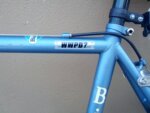Going from a triple to a double – what don’t I know?
Our Community › Forums › Bikes & Equipment › Going from a triple to a double – what don’t I know?
- This topic has 158 replies, 22 voices, and was last updated 7 years, 7 months ago by
 jrenaut.
jrenaut.
-
CreatorTopic
-
February 11, 2017 at 7:24 pm #919086
 jrenautParticipant
jrenautParticipantMy “I don’t have the kids but the fixie is impractical for this ride” bike is a 2013 Bianchi Volpe. It came with a triple up front – 50/39/30.
I’d like to switch to a double. The only time I ever use the small ring is when I accidentally downshift, and then I use it only long enough to get back into the middle ring.
Can I just replace the crankset and the front brifter? Or is there more to it than that? Since Shimano sells 2X10 and 3X10 derailleurs, I assume i’d have to replace that, too. Would I have to do 50/39? And how do I get the crankset off?
-
CreatorTopic
-
AuthorReplies
-
February 11, 2017 at 7:50 pm #1065876
ImaCynic
Participant@jrenaut 154779 wrote:
My “I don’t have the kids but the fixie is impractical for this ride” bike is a 2013 Bianchi Volpe. It came with a triple up front – 50/39/30.
I’d like to switch to a double. The only time I ever use the small ring is when I accidentally downshift, and then I use it only long enough to get back into the middle ring.
Can I just replace the crankset and the front brifter? Or is there more to it than that? Since Shimano sells 2X10 and 3X10 derailleurs, I assume i’d have to replace that, too. Would I have to do 50/39? And how do I get the crankset off?
I believe the crankset width is slightly different between a double and triple. If you can find a matching double, it should work. This, with a double FD and a matching shifter should be all you need. A compact double is 50/34, which should work well for you. Lastly, most current Shimano cranks can be removed with just a Allen wrench, but you will need a special tool to remove the bottom bracket, if necessary.
Good luck!
Sent from my XT1575 using Tapatalk
February 11, 2017 at 7:55 pm #1065878peterw_diy
ParticipantWhy not try adjusting the limit screws and cable tension so your brifter can’t drop to the granny? If it works you can then decide whether to go full weight weenie and remove the small ring.
February 11, 2017 at 8:27 pm #1065880hozn
ParticipantGo single ring! It is awesome.
February 11, 2017 at 8:36 pm #1065882TwoWheelsDC
ParticipantShifter, derailleur, crankset should be all you need, but you should also redo the cables/housing while you’re at it. Getting the crank off will depend based on the manufacturer, but it shouldn’t involve special tools unless you also need/want to swap out the bottom bracket as well…and if you’re already pulling the crank off you might as well at least pull out your BB and re-grease everything.
For the Volpe, you’d probably want to stick with a 50/34…but if you move to a 53, search online and make sure you have the clearance for the bigger crank.
February 11, 2017 at 9:27 pm #1065883hozn
ParticipantDefinitely don’t get a standard (39/53) crankset; that would needlessly limit your range and really doesn’t make any sense anywhere there are any hills.
February 11, 2017 at 9:33 pm #1065884hozn
ParticipantIf you do decide to go 1x (which really is great), beware that the 1x rings are often offset inboard, so you won’t be able to fix as large a 1x ring as a regular ring. But 1x means new rear derailleur and new cassette. No need to replace your font shifter, though, unless a non functional shifter paddle offends you.
And probably no need to replace your crankset if going to 1x, since you don’t care about FD alignment with the double. Chain line might be a little too far outboard, but it likely won’t matter.
February 11, 2017 at 10:29 pm #1065885dkel
ParticipantMy double is 46/36, and I almost never get onto the smallest cog with the big ring around here. I guess I’m not as much of a beast as all y’all.
Would a new derailleur really be necessary? Doesn’t the indexing in the shift lever execute the proper spacing independently of the derailleur? I suppose there could be trouble with the limit screws being too wide on either end…or is there some angle to the movement of the derailleur that is different for 2x?
February 11, 2017 at 10:38 pm #1065886vvill
ParticipantYep – FD, 2x brifter and crankset. Most non-powermeter cranksets come with chainrings so you wouldn’t re-use those from your 50/39/30 (which probably use a 130/74 BCD anyway).
Some typical road/gravel/CX chainring combos are 53/39, 52/36, 50/34 and 46/36 (for cyclocross). I’d suggest a 34 as the small ring instead of a 39, for the same reasons as hozn mentioned. Though a 36 would be okay too with the wide range cassettes available these days.
You will probably need a tool to get the preload cap off the crankset. I would probably get one of these if you expect to service Shimano BB/cranksets often. It’s also the same one used with SRAM GXP, and quite a few other BBs. (You can also use it with Centerlock disc rotor lockrings with external notches.)
http://www.parktool.com/product/bottom-bracket-tool-bbt-9When choosing a crankset just be aware that chainrings are not quite as interchangeable across manufacturers as they used to be so your choice may limit you to certain brands of chainrings in future. Shimano now use 4-bolts instead of 5 on their chainrings. SRAM still uses 5, although newer ones have one of the five recessed behind the driveside crank.
February 12, 2017 at 2:36 am #1065904 jrenautParticipant
jrenautParticipantI think 1x is a little too inflexible. I do sometimes use this bike for dragging a bunch of groceries you the hill.
52×36 sounds perfect. Just a little bigger in the big ring, but a little smaller in the small one.
Sent from my XT1650 using Tapatalk
February 12, 2017 at 3:12 am #1065908hozn
Participant1x does not mean less range! (An 11-42 cassette with a 50t ring is more range than a 34/50 rings with 11-28 cassette.). It does mean bigger steps between some of the cogs, but when you consider that there are only ~14 usable gears in a typical double setup, doing 1×11 only misses a few cog sizes. In practice, I notice that it goes from 13 to 15 (missing 14), but it isn’t a problem.
For my commuter an 11-36 cassette with a 46t ring is a little more range than 11-28 cassette with 36/46 cx rings.
And 100rpm with a 46×11 is 33mph, so that gearing is still fast enough for the HP hot laps, though maybe not quits for the sprint point.
February 12, 2017 at 3:23 am #1065909hozn
ParticipantFor double rings, 36/52 is great alternative to a standard, but honestly a 50t is pretty fast. Pedaling at 100rpm in 50×11 is 36mph, 110rpm is 39mph. I can’t think of a single race scenario where I needed to be *pedaling* at over 40mph. There are definitely people who can use that gearing, maybe sprinters who want to turn over a taller gear at lower cadences? Anyway, I used a 36/52 for the last year, but I like a 50t ring better, so my road bike now has a 50t.
February 12, 2017 at 9:28 pm #1065932dkel
Participant@hozn 154815 wrote:
1x does not mean less range! […] It does mean bigger steps between some of the cogs, but when you consider that there are only ~14 usable gears in a typical double setup, doing 1×11 only misses a few cog sizes. In practice, I notice that it goes from 13 to 15 (missing 14), but it isn’t a problem.
My 1×8 IGH doesn’t boast a big range, but it does cover commuting and errands nicely, including grocery runs. There are only a couple of short segments on my 7-mile commute where I feel a “gap” in the range, but that’s easily mitigated by either patience or enthusiasm.
February 13, 2017 at 3:32 pm #1065992EasyRider
ParticipantI agree with Hozn, go 1×10, for the novelty and weight savings. A 52/36 will replicate the gearing you have now, except it will eliminate your hill climbing gears. A 50/39 and a 52/36 have almost the same gear range, with a 11-28 cassette, which is what I’m guessing you have.
from Sheldon’s gear calculator:
52/36: 127 gear inches, 35 gear inches
50/39: 123 gear inches, 38 gear inches
50/39/30: 123 gear inches, 30 gear inches.Hozn, could jrenaut get a cheap taste of 1×10 by just removing the big and small rings on the current crankset, and front der, and replace the middle ring with a 38t or 40t WolfTooth? Prob couldn’t go bigger that that without hitting the chainstay, but that’d still be a 100″ high gear and 40″ low.
February 13, 2017 at 4:00 pm #1065994 drevilParticipant
drevilParticipant@EasyRider 154903 wrote:
Hozn, could jrenaut get a cheap taste of 1×10 by just removing the big and small rings on the current crankset, and front der, and replace the middle ring with a 38t or 40t WolfTooth? Prob couldn’t go bigger that that without hitting the chainstay, but that’d still be a 100″ high gear and 40″ low.
When I set up 1x on my mountain bikes, a narrow wide chainring like the Wolftooth was important to keeping the chain on, but almost as important was a “clutch” style rear derailleur that resists chain slackening. This is important in mountain biking where your bike/drivetrain/chain is bouncing around a lot. I believe most, if not all, decent to higher end mountain bike rear derailleurs are “clutch” now.
I know diddly about road components, but are they as prominent there as well?
February 13, 2017 at 4:01 pm #1065995hozn
Participant@EasyRider 154903 wrote:
Hozn, could jrenaut get a cheap taste of 1×10 by just removing the big and small rings on the current crankset, and front der, and replace the middle ring with a 38t or 40t WolfTooth? Prob couldn’t go bigger that that without hitting the chainstay, but that’d still be a 100″ high gear and 40″ low.
Yeah, that should work fine. I think the clutch derailleurs add some confidence (no chain drops), but will work with normal — just not so much range, as you point out.
-
AuthorReplies
- You must be logged in to reply to this topic.